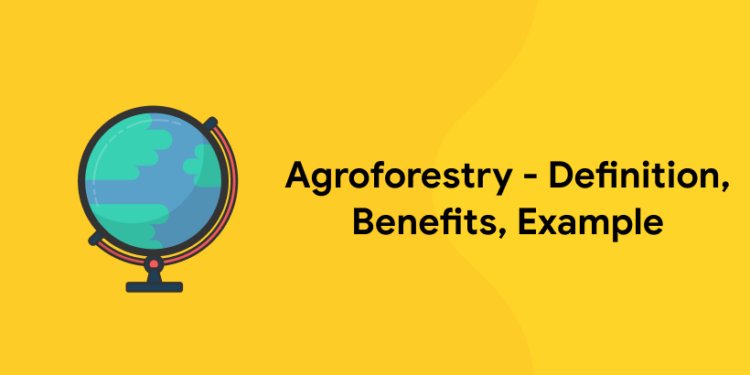Table of Contents
The environment concerns of the modern era is increasing day by day. The society is giving more importance to the economy and industry, the often sacrificed one among them will be environment. The governments of different countries are having conferences and multilateral agreements to cope with the threat of environmental problems. The major areas that are to be protected and conserved in a non-industry perspective is forest and agriculture. Both of the terms may be seen as added version of environment but it is not. Agriculture is the human action of growing crops grains whereas forest is a natural phenomenon. The modern techniques have introduced a hybrid term called Agroforestry in order to protect the both. Through this blog let us discuss what is agroforestry and what all are its benefits and advantages.
Enroll Entri to get Latest Updates on General Awareness for your Preparation
What is Agroforestry – Definition and Overview
Agroforestry is a hybrid term or mixed term of forestry and agriculture. Agriculture is a human phenomenon or action by which the food crops or cash crops are cultivated. A lot of land is used for the same. Not only land but also technology and labor irrigation is required to nourish agriculture. The land used for agriculture is often created from clearing forest. The initial man cleared forests and used that land for agriculture. Agriculture is the primary sector of the economy and the base of the food chain. Maybe you see agriculture and forestry as synonyms but they are entirely different.
On the other hand, forestry is having different meaning. Forest is a natural phenomenon. We have plenty of forest in our planet and in our area too. Forestry is the act of building forest by planting too many trees on a specified area. These kinds of man-made forest can be seen in different parts of our country. In order to cope with the climatic conditions and global warming, forestry practice is encouraged. If forestry is encouraged, it utilises the land for cultivation or agriculture.
Agroforestry is modern term where forestry and agriculture are combined in the same land using modern technology. The practice of mixed cropping adopted in agriculture in an advanced way can be portrayed to form agroforestry. Certain kinds of trees and desired crops are inter planted and cultivated to form agroforestry. It is the practice of having the forest and agriculture on the same land by reducing extra land
 Agroforestry Classification
Agroforestry Classification
1: Who was the first woman President of India?
Even though the agroforestry seems to be so simple in its definition it has various kinds and different categories in it. The different categories of agroforestry depend upon what is cultivated and what is planted in the land for implementing agroforestry. The major classification of the agroforestry are as follows:
- Agri-silvicultural systems
- Agrosilvopastoral systems
- Silvopastoral System
Agrisilvicultural systems
Agrisilvicultural systems are a combination of crops and trees, such as alley cropping or homegardens. Silvopastoral systems combine forestry and grazing of domesticated animals on pastures, rangelands or on-farm.
Enroll Entri to get Latest Updates on General Awareness for your Preparation
Agrosilvopastoral systems
Agro-silvopastoral systems are land-use practices in which trees and crops are integrated into livestock production, and they play an essential role in reducing vulnerability and increasing crop resilience, thus helping communities better tackle climate risks.
Enroll Entri to get Latest Updates on General Awareness for your Preparation
Silvopastoral System
Silvopastoral systems (SPS) are a type of agroforestry that allows the intensification of cattle production based on natural processes that are recognized as an integrated approach to sustainable land use. In the modern way the silvopastoral system has given way to an intensive silvopastoral system. Intensive Silvopastoral Systems (iSPS) are a type of SPS that combine high-density cultivation of fodder shrubs (4.000 to 40.000 plants per ha) with: (i) improved tropical grasses; and (ii) trees species or palms at densities of 100–600 trees per ha. These systems are managed under rotational grazing with occupation periods of 12 to 24 hours and 40 to 50 day resting periods, including ad libitum provision of water in each paddock.
The Benefits of Agroforestry
There are various benefits for the agroforestry in different perspectives. The major benefits can be described as below.
- It enhances biodiversity. Various kinds of trees and crops are interlinked and allowed to grow together, resulting in enhanced biodiversity.
- Sustainable development. This method will not sacrifice agriculture for the forest and forest for agriculture. Thus, the primary sector of economy and environment is developed altogether to form a sustainable development
- The fertility of the soil will be enhanced and protected. Intensive agriculture will tamper the soil fertility by chemical fertilizers or the same kind of agriculture. This method will increase the natural fertility of the soil.
- The climatic condition of the earth can be protected. Agroforestry on a wide scale can reduce the greenhouse effect and reduce global warming in considerable ways.
- It will create a natural habitat for the animals. Thus, animal friendly nature can be implemented.
 Conclusion
Conclusion
The practice of agroforestry is a matter of study in the modern world. It will be a branch that will be enhanced day by day and will form as a solution to the modern world problem. A competitive exam aspirant who is required to know their surroundings needs to know about agroforestry. Study the above facts and information as notes on agroforestry. Keep enrolled in Entri to get the latest update on the agroforestry for the betterment of your study. Keep studying, keep winning.













